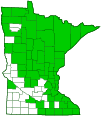rough bedstraw
(Galium asprellum)
Conservation • Wetland • Description • Habitat • Ecology • Use • Distribution • Taxonomy
Conservation Status |
|
|||||||
| IUCN Red List | not listed |
|||||||
| NatureServe | NNR - Unranked SNR - Unranked |
|||||||
| Minnesota | not listed |
|||||||
Wetland Indicator Status |
||||||||
| Great Plains | OBL - Obligate wetland |
|||||||
| Midwest | OBL - Obligate wetland |
|||||||
| Northcentral & Northeast | OBL - Obligate wetland |
|||||||
Description |
||
Rough bedstraw is a sprawling, up to 7′ long, perennial forb that rises from a creeping rhizome. The stems lie flat on the ground (prostrate) or climb awkwardly on adjacent vegetation (scrambling). They are slender, weak, 4-angled, usually much branched, and green, sometimes tinged with red. They are rough with minute, stiff, prickly, downward curved (hooked) hairs on the angles and usually also between the angles. The nodes of the stem are often surrounded with a ring of short, straight, spreading hairs. The leaves are spreading or slightly ascending and stalkless. They are in whorls of 6 on the main stem, whorls of 4 or 5 on the branches. The blades are narrowly elliptic to inversely lance-shaped, ⅜″ to ¾″ long, and ⅛″ to ¼″ wide. They are widest above the middle, sharply pointed at the tip, and angled or squared off at the base. They have a single prominent vein running from the base to the tip, and an abrupt, short, sharp, firm point at the tip. The upper surface is hairless. The lower surface is hairless except for short, stiff, prickly hairs along the midrib. There are no glands (appearing as lines or streaks) on the lower surface. The margins are untoothed and are often somewhat curled under. They are rough with a fringe of short, stiff, prickly hairs. The inflorescence is a small, branched, few-flowered cluster at the end of the stem and rising from the upper leaf axils. The inflorescence branches are ascending, held above the leaves, and forked 1 to 3 times. The flowers are ⅛″ wide. There are no sepals, 4 petals, 4 stamens, and 2 styles. The petals are white, joined at the base into a minute tube, then separated onto 4 lobes. The lobes are spreading, egg-shaped, and pointed at the tip. The stamens have yellow anthers and are shorter than the corolla. The styles are shorter than the corolla and are topped with a white, head-like stigma. The ovary has two chambers and 2 lobes. The fruit is a green, hairless, 1 ⁄32″ to 1 ⁄16″long, 1 ⁄32″ wide, 1-seeded capsule, joined in pairs and separating at maturity. |
||
Height |
||
Sprawling: up to 7′ long |
||
Flower Color |
||
White |
||
Similar Species |
||
Shining bedstraw (Galium concinnum) has no hooked hairs on the stem or leaves. The leaves are narrower, no more than ⅛″ wide. |
||
Habitat |
||
Wet. Woods, thickets, marshes, swamps, calcareous fens, and streamsides. |
||
Ecology |
||
Flowering |
||
July to September |
||
Pests and Diseases |
||
|
||
Use |
||
|
||
Distribution |
||||
|
Sources |
|||
| 3/24/2023 | ||||
Nativity |
||||
Native |
||||
Occurrence |
||||
Common |
||||
Taxonomy |
|||
| Kingdom | Plantae (green algae and land plants) | ||
| Subkingdom | Viridiplantae (green plants) | ||
| Infrakingdom | Streptophyta (land plants and green algae) | ||
| Superdivision | Embryophyta (land plants) | ||
| Division | Tracheophyta (vascular plants) | ||
| Subdivision | Spermatophytina (seed plants) | ||
| Class | Magnoliopsida (flowering plants) | ||
| Superorder | Asteranae | ||
Order |
Gentianales (gentians, dogbanes, madders, and allies) | ||
Family |
Rubiaceae (madder) | ||
| Subfamily | Rubioideae | ||
| Tribe | Rubieae | ||
Genus |
Galium (bedstraws) | ||
Subordinate Taxa |
|||
|
|||
Synonyms |
|||
|
|||
Common Names |
|||
rough bedstraw |
|||
Glossary
Axil
The upper angle where a branch, stem, leaf stalk, or vein diverges.
Bract
Modified leaf at the base of a flower stalk, flower cluster, or inflorescence.
Carpel
The female reproductive organ of a flower, consisting of an ovary, styles, and stigmas.
Corolla
A collective name for all of the petals of a flower.
Node
The small swelling of the stem from which one or more leaves, branches, or buds originate.
Panicle
A pyramidal inflorescence with a main stem and branches. Flowers on the lower, longer branches mature earlier than those on the shorter, upper ones.
Rhizome
A horizontal, usually underground stem. It serves as a reproductive structure, producing roots below and shoots above at the nodes.
Visitor Photos |
|||||
Share your photo of this plant. |
|||||
| This button not working for you? Simply email us at info@MinnesotaSeasons.com. Attach one or more photos and, if you like, a caption. |
|||||
|
|||||
MinnesotaSeasons.com Photos |
|||||
|
|||||

Slideshows |
||

Visitor Videos |
|||
Share your video of this plant. |
|||
| This button not working for you? Simply email us at info@MinnesotaSeasons.com. Attach a video, a YouTube link, or a cloud storage link. |
|||
Other Videos |
|||

Visitor Sightings |
|||||
Report a sighting of this plant. |
|||||
| This button not working for you? Simply email us at info@MinnesotaSeasons.com. Be sure to include a location. |
|||||
|
|||||
MinnesotaSeasons.com Sightings |
|||||

|
Created: Last Updated: © MinnesotaSeasons.com. All rights reserved. |
